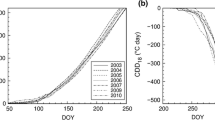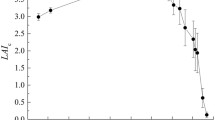Abstract
The photosynthetic development of pedunculate oak (Quercus robur L.) sun leaves in a mature woodland canopy in Oxfordshire, southern England, was investigated in situ during 3 years with contrasting weather conditions. Development of full photosynthetic capacity (indicated by light-saturated net assimilation rates, A max, typical of the summer period) took between approximately 50 and 70 days after budbreak in different years. This slow development means that these leaves do not utilise a substantial fraction of the seasonal peak of solar irradiance. During the late autumn senscence period the photosynthetic capacity declined over a 2-week period, but as this is a time of low irradiance, the loss of potential photosynthesis was relatively small. The consequences of these developmental changes and differences in bud break dates for daily and seasonal leaf carbon balance were investigated through a simple light-response photosynthetic model. Seasonal changes in photosynthetic capacity would decrease annual carbon uptake per unit leaf area by about 23% compared to that potentially possible if leaves photosynthesised at peak rates throughout the growing season. This difference is likely to be up to 30% larger in years with late budburst and as low as 18% in years with early budburst.




Similar content being viewed by others
References
Bassow SL, Bazzaz FA (1998) How environmental conditions affect canopy leaf-level photosynthesis in four deciduous tree species. Ecology 79:2660–2675
Bolhàr-Nordenkampf GO, Öquist HR (1993) Chlorophyll fluorescence as a tool in photosynthesis research In: Hall DO, Scurlock JMO, Bolhàr-Nordenkampf GO, Leegood RC, Long SP (eds) Photosynthesis and production in a changing environment: a field and laboratory manual. Chapman & Hall, London, pp 193–206
Breda N, Cochard H, Dreyer E, Granier A (1993) Water transfer in a mature oak stand (Quercus petrea): seasonal evolution and effects of a severe drought. Can J For Res 23:1136–1143
Cowley JP (1978) The distribution over Great Britain of global solar irradiation on a horizontal surface. Meteorol Mag 107:357–373
Goudriaan J (1986) A simple and fast numerical method for the computation of daily totals of crop photosynthesis. Agric For Meteorol 38:249–254
Hollinger DY (1992) Leaf and simulated whole-canopy photosynthesis in 2 co-occurring tree species. Ecology 73:1–14
Jurik TW (1986) Seasonal patterns of leaf photosynthetic capacity in successional northern hardwood tree species. Am J Bot 73:131–138
Kramer K, Leinonen I, Loustau D (2000) The importance of phenology for the evaluation of impact of climate change on growth of boreal, temperate and Mediterranean forests ecosystems: an overview. Int J Biometeorol 44:67–75
Marshall B, Biscoe PV (1980) A model for C3 leaves describing the dependence of net photosynthesis on irradiance. I. Derivation. J Exp Bot 31:29–39
Menzel A (2000) Trends in phenological phases in Europe between 1951 and 1996. Int J Biometeorol 44:76–81
Menzel A, Estrella N, Fabian P (2001) Spatial and temporal variability of the phenological seasons in Germany from 1951 to 1996. Global Change Biol 7:657–666
Morecroft MD, Roberts JM (1999) Photosynthesis and stomatal conductance of mature canopy oak (Quercus robur) and sycamore (Acer pseudoplatanus) trees throughout the growing season. Funct Ecol 13:332–342
Morecroft MD, Taylor ME, Oliver HR (1998) Air and soil microclimates of deciduous woodland compared to an open site. Agric For Meteorol 90:141–156
Morecroft MD, Burt TP, Taylor ME, Rowland AP (2000) Effects of the 1995–1997 drought on nitrate leaching in lowland England. Soil Use Manage 16:117–123
Myneni RB, Keeling CD, Tucker CJ, Asrar G, Nemani RR (1997) Increased plant growth in the northern high latitudes from 1981 to 1991. Nature 386:698–702
Ogink-Hendriks MJ (1995) Modelling surface conductance and transpiration of an oak forest in The Netherlands. Agric For Meteorol 74:99–118
Reich PB, Walters MB, Ellsworth DS (1991) Leaf age and season influence the relationship between leaf nitrogen, leaf mass per area and photosynthesis in maple and oak trees. Plant Cell Environ 14:251–259
Roberts J, Hopkins R, Morecroft M (1999) Towards a predictive description of forest canopies from litter properties. Funct Ecol 13:265–272
Shabanov NV, Zhou LM, Knyazikhin Y, Myneni RB, Tucker CJ (2002) Analysis of interannual changes in northern vegetation activity observed in AVHRR data from 1981 to 1994. IEEE Geosci Remote 40:115–130
Sparks TH, Carey PD (1995) The responses of species to climate over two centuries: an analysis of the Marsham phenological record, 1736–1947. J Ecol 83:321–329
Stokes VJ (2002) The impact of microenvironment, leaf development and phenology on annual carbon gain and water loss of two deciduous tree species. PhD Thesis, University of Essex, Colchester, UK
Thomas PT (2000) Trees: their natural history. Cambridge University Press, Cambridge
Tucker CJ, Slayback DA, Pinzon JE, Los SO, Myneni RB, Taylor MG (2001) Higher northern latitude normalized difference vegetation index and growing season trends from 1982 to 1999. Int J Biometeorol 45:184–190
Wilson KB, Baldocchi DD, Hanson PJ (2000) Spatial and seasonal variability of photosynthetic parameters and their relationship to leaf nitrogen in a deciduous forest. Tree Physiol 20:565–578
Wilson KB, Baldocchi DD, Hanson PJ (2001) Leaf age affects the seasonal pattern of photosynthetic capacity and net ecosystem exchange of carbon in a deciduous forest. Plant Cell Environ 24:571–583
Acknowledgements
We thank Dr. Lionel Cole for providing some of the phenological data. We are grateful to the Natural Environment Research Council for a studentship to V.J.S. and for funding monitoring and research at Wytham under the UK Environmental Change Network.
Author information
Authors and Affiliations
Corresponding author
Additional information
Prepared in conjunction with the International Conference "The times they are a-changin'". Climate change, phenological responses and their consequences for biodiversity, agriculture, forestry and human health, held in Wageningen, The Netherlands, 5–7 Dec 2001
Rights and permissions
About this article
Cite this article
Morecroft, M.D., Stokes, V.J. & Morison, J.I.L. Seasonal changes in the photosynthetic capacity of canopy oak (Quercus robur) leaves: the impact of slow development on annual carbon uptake. Int J Biometeorol 47, 221–226 (2003). https://doi.org/10.1007/s00484-003-0173-3
Received:
Accepted:
Published:
Issue Date:
DOI: https://doi.org/10.1007/s00484-003-0173-3




